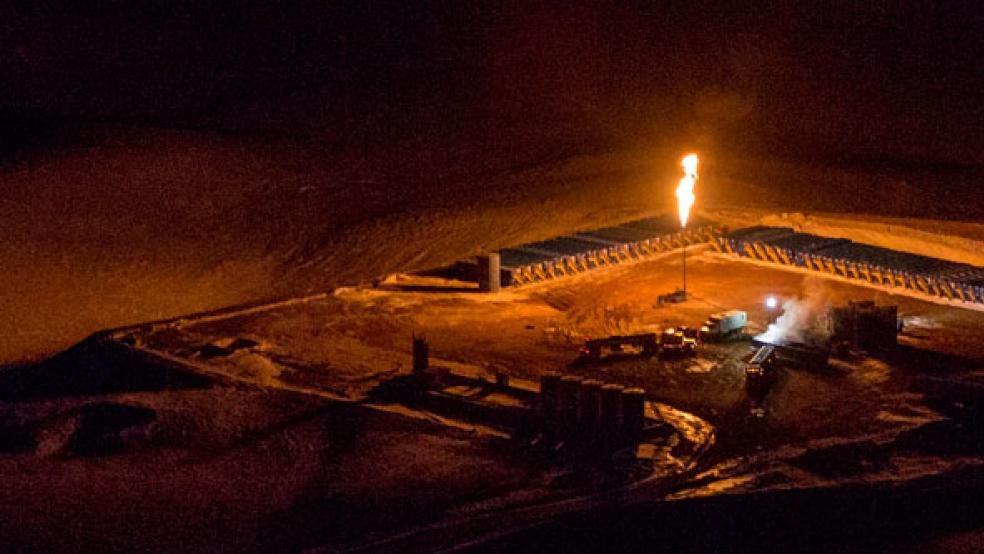Just over a decade ago, this sleepy farming community on the fringe of North Dakota's Bakken shale formation hosted the state's first horizontal oil well to be hydraulically fractured, or fracked, helping set in motion an economic revolution that shook the world.
Today, Divide County may be another vanguard for the state, this time ominous, as the first to feel the full effect of a collapse in prices that has lopped more than 50 percent off the price of oil since the summer.
Related: Why Oil Prices Are Headed Below $35 a Barrel
Only five oil rigs were drilling in Divide County this week, down from 12 last August, according to state data. While those only account for a handful of the more than 162 rigs still drilling in North Dakota, the drop has been much steeper than elsewhere in the state and could signal trouble across the No. 2 U.S. oil producer behind Texas if prices continue to slide.
A "Coming Soon" sign still marks the spot on a patch of fallow farmland just outside of Crosby, the county seat, where a 200-person "man camp" to house oil workers was set to be built. Late last fall, Timberline Construction Group, an Alabama-based contractor, put the project on hold after an oil company pulled out of a housing contract.
In downtown Crosby, restaurants and bars report fewer rig workers, and foot traffic has noticeably slowed. Two businesses have been put up for sale.
"We still have our regulars, but the number of oil workers has thinned," said Bill Waters, owner of the Crosby Self-Serve, a popular lunch spot festooned with Coca-Cola memorabilia.
Related: North Dakota Oil Boom Pays for College
To be sure, it's far from doomsday for this town of 1,200, which is more reliant on wheat farming and ranching. The county pumps 3.4 percent of the 1.2 million barrels of oil produced daily in the state. Yet the slowdown in oil business is more apparent in Crosby than some much-larger oil boomtowns such as Williston, just 70 miles (113 kilometers) south, which still appear to be thriving - albeit with gnawing trepidation - as oil prices continue their downward march.
Other oil-producing parts of the United States are also watching oil's fall anxiously, with producers hunkering down. The diverging fortunes illustrate how drillers are moving swiftly to pull back from marginal areas, even while still going full-tilt in the richest seams.
Cheap Oil Changes Things
Continental Resources Inc, the state's No. 2 oil producer, drilled that first horizontal well to be fracked in Divide in March 2004. But Continental gradually moved south after drilling that well, which initially produced more water than oil, and for 2015 has hunkered down in so-called "sweet spots" that have higher oil reserves and thus tend to be more-economical to drill.
That's partly because the state's Bakken shale formation is geologically immature throughout most of Divide County, only 40 feet in width here versus 60 feet in richer counties further south, according to state records.
Related: Earnings, Oil and Volatility Will Be Center Stage
"Divide County is a little bit on the edge," said Julie LeFever of the North Dakota Geological Survey. "Each part of the Bakken has its own little idiosyncrasies."
The four counties immediately south - Williams, McKenzie, Dunn and Mountrail - now produce 90 percent of the state's oil, and Divide was mostly left for smaller companies willing to take the risk when oil prices were riding near $100 a barrel. At under $50 a barrel, the economics change dramatically. The breakeven oil price, the price level needed to drill a new well, for Divide County is $85 a barrel, according to the state; for Williams, it's just $37. The difference is due to geology, among other factors.
Giving Up
It is perhaps little surprise, then, that a company focused exclusively on Divide County has emerged as one of the earliest hit by the collapse in oil markets. Last week American Eagle Energy Corp said it had stopped drilling and sold off its oil hedges for a cash infusion. Only a few are holding out, hoping things turn around.
Last week, a Nabors Industries rig contracted to SM Energy was visibly drilling well into the night, steam rising as crews drilled deep into the earth despite plunging temperatures approaching -20 Fahrenheit (-29 Celsius).
Related: Cracks in the Armor of North Dakota's Fracking Boom
SM is the only publicly traded company still operating in the county and most of its holdings are outside North Dakota. But it was able to gain a small foothold in the state last fall with a $335 million buyout of some Baytex Energy acreage.
SM said it considers its Divide holdings "the best stuff we have" in North Dakota, spokesman James Edwards said.
For now, SM's Nabors rig is a rare holdout in a county experiencing the onslaught of cheap oil. "We realize this is all part of the commodity-price cycle," said Bert Anderson, Crosby's mayor. "This is the nature of it."


